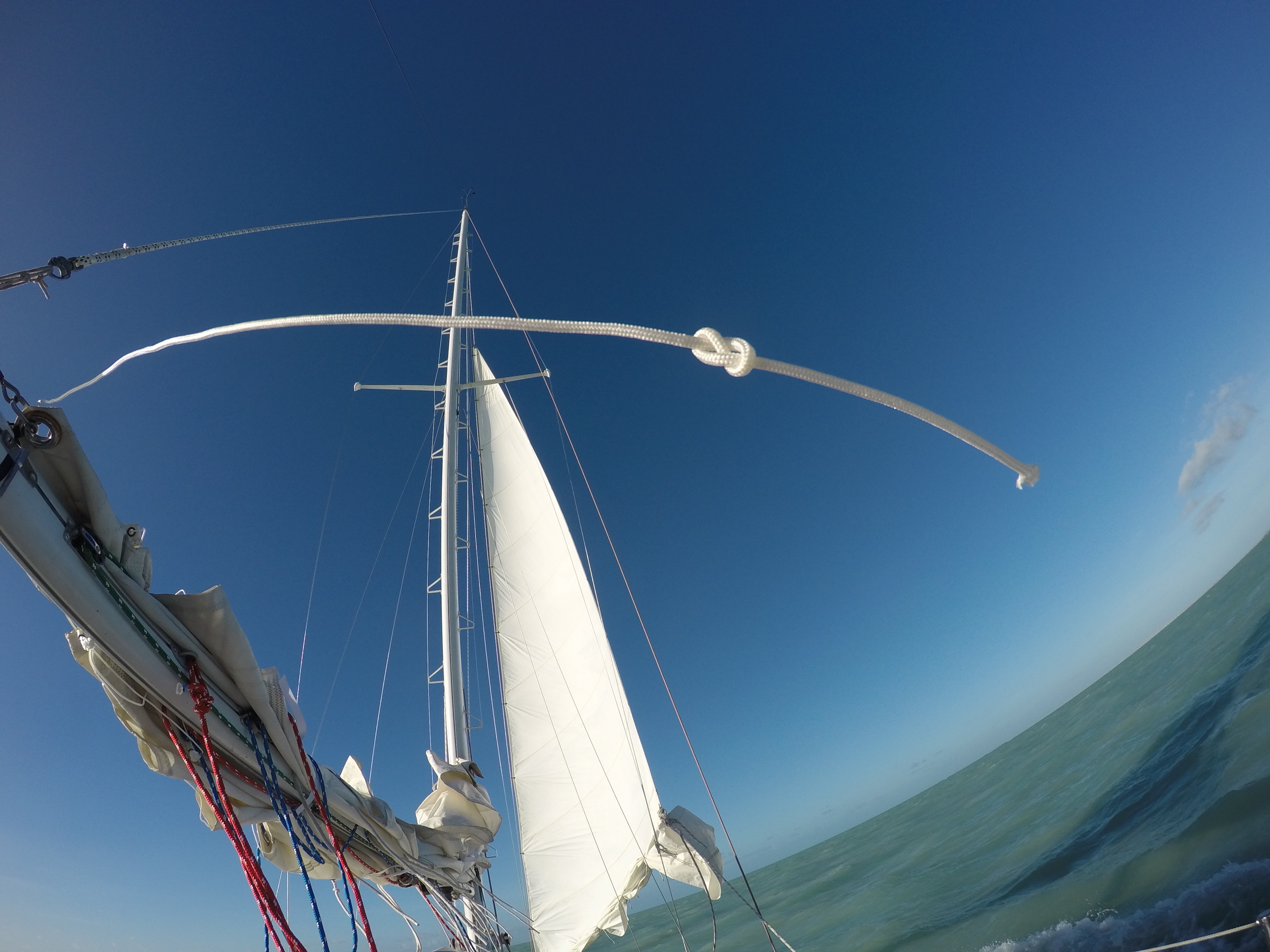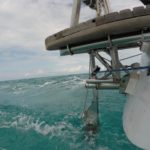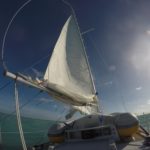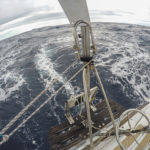Considering Boot Key Harbor’s “sticky water” reputation, and the fact that we are still chit-chatting with friends well past noon in the City Marina parking lot after returning from our, yes, third trip to the hardware store that day, it’s understandable that people have doubts about us actually leaving on our stated departure day of November 28. But Lord-Have-Mercy we prove them wrong! Maybe we aren’t making headway for the Bahamas by the time the sun sets, but we are outside of the harbor, anchored in the lee of Boot Key, and awaiting tomorrow’s first light for an early departure.

The boat is beyond packed, things piled up all over, and more bags of things yet to be unloaded. It’s overwhelming, intimidating even. We do our best that evening to get things stowed, but considering how little we’ve used the boat over most of the past year, our idea of ship-shape has become a bit lax. Well if I just consolidate all of the stuff spread out over the nav-station into one basket that oughtta be alright, is a mental process that occurs that night. But what do I care? For better or worse at least now everything we own is on the boat, and the boat is out of the harbor, and we are starting the trip of our lifetimes tomorrow morning! Speaking of, it’s after midnight, I was already exhausted six-hours ago, can we go to bed yet?
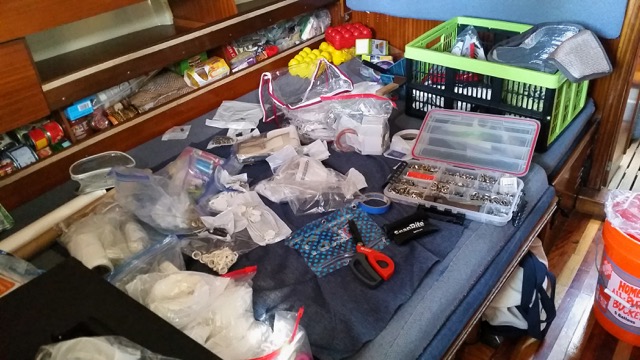
Clare, my very own princess-and-the-pea, doesn’t sleep well unless the earth stops spinning, so our recent re-acquaintance with anchoring in 20-knot winds leaves her waking up on the proverbial wrong side of the bed—a bed that wasn’t visited until after midnight, you remember, and from which we must exit at first light. Rough start to the day. I’m tired too, of course, but I’m also bouncing like a labrador retriever, giddy at the thought of going anywhere…especially after I slug down some cuban coffee. So we get the anchor up and the boat underway. We set the sails and have to tack twice to get out past the reef. It seems that half the day is already past by the time we are finally in deep royal blue water, and the Gulf Stream is still miles more to go.
The forecasted SE wind turns out to be little more than perhaps a dozen degrees south of east—the difference between hiking a moderate incline all day, and clambering up some steep terrain. The wind is now blowing a sustained 25 knots, with gusts into the thirties, and the seas are 5-7 feet in height. Don’t get me wrong, our boat can handle these conditions, in fact most any sailboat in reasonable condition can, and I never doubt her for a minute. But remember that bit above about the boat being full of stuff and us being a bit rushed on packing? Well we should’ve taken a photograph because our shit went EVERYWHERE, and that was just within the first hour of sailing. After initialing trying to pick up some of the pieces, we soon realize its better just to let everything stay wherever it decides to settle—at least then it won’t move again until the next tack.
Turns out our bodies aren’t very used to being in ship-shape either. Clare gets seasick for the first time EVER, and I lead the charge by making sure the fish are well fed. It’s one thing to go out sailing in difficult conditions, and another thing entirely to do so when you’d rather be dead. All the more respect to our sailing friends who continue to go to sea knowing nothing different…I don’t know how you do it! On the plus side we don’t have to worry one wink about food prep, but we have a hell of a time doing anything other than lying in the cockpit, trying to keep down water.
So we’re plodding along, making good time mind you, but being punished for it. Nightfall comes and so too does the busy Straits of Florida traffic. I’ve sailed to the Bahamas a handful of times now, but this is my first time with AIS. Automated Identification System uses VHF radio frequencies to display the location, course, and speed of all transmitting vessels, and basically all commercial traffic—including big fuck-off container ships, the type that wouldn’t even realize they had run you over if they did—are required to have transmitters.
This is a big bonus for small-fries like us. We can see these monsters moving on our screen, calculate if our paths will cross, and even hail them over the radio by name. As I’ve learned from prior crossings, it’s much easier to get a skipper on the horn if you can call out the vessel by name rather than by some lame series of approximations like, “Vessel in the vicinity of N 24.35 degrees by W 79.84 degrees, appearing to be on a SW heading and with three white lights, please come back…” yeah, that never worked out too well.
But now, with AIS, I can even get responses from cruise ships, which we do, and explain that we are a small sailing vessel at such-and-such coordinates, that we are under sail alone and with sick crew, and can you please alter your course ten degrees to the west? “No problem captain, we see you on radar now. Please maintain your speed and heading and we will alter our course.” Holy fucking magic, this thing is awesome! So I have about four or five conversations like this over the course of the night as I continually monitor the moving triangles on my chart plotter screen in between serving fresh rounds to the fish overboard.
CJ covers a pile of spilled junk with a spare cushion and tries to get some rest on the floor down below, as our boat hurtles and thuds through wave after wave. I curl up in a ball in the cockpit and do my best to minimize the openings in my foul weather gear as a perfunctory defense against those same waves that ceaselessly crash, break, and wash all over our decks. It definitely feels as if we are on a wet ’n wild amusement park ride. Actually yeah, imagine your favorite water park ride. You got it? The whoosing and gushing, the splash and spray, the tug of gravity as water gives way, your stomach dropping and lifting. Remember those feelings? Now envision staying on that ride for an entire hour, then another hour, and then another. How about 24 hours? How about 48? Still having fun?
When we left Marathon, our intention was to ride this wind across the Straits of Florida, all the way across the Great Bahama Bank, through the NW Channel, down the Tongue of the Ocean and into a small village on the island of Andros named Morgan’s Bluff. A trip, we figured, that should take us about 42 hours. Well by the time we are half-way across the Gulf Stream it is blatantly apparent that hitting our necessary waypoint will require at least two more tacks and who knows how many more hours of wet ’n wild maddening travel. Or, we can maintain our current heading and land right smack in the middle of the Bimini islands. Um, decision made.
Day breaks and with it a bit of the drudgery. The sun warms our skin once again and stomachs finally seem to settle. Passing ships can be seen as more than just a few blips of moving light. Daylight though, exposes the bad just as much as the good. A boat that is thoroughly disheveled no doubt requires a bit of work to re-order, fair enough. But a boat that is saturated throughout with the sticky sweat slag of seawater is another beast altogether. Turns out that our “water tight” boat is really more “water resistant.” Even with all the hatches dogged down, and even though nearly all of our deck hardware has been recently rebedded in fresh sealant, and even though our hull-to-deck join is literally fiberglassed together, somehow, somewhere, seawater found its way throughout our vessel and into nearly everything aboard.
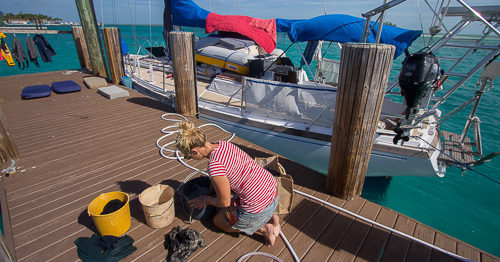
The whole interior feels like a wrung out briny sponge. The cushions literally are such. The walls are covered in salt crystals. Fortunately Clare packed our electronics in plastic bags before storing them because we literally pour standing seawater from one such storage basket. What the &%$# happened down here? Honestly, we’re dumbfounded. We have the blessing/curse of a boat with an extensive inner liner. This makes for an interior that looks very finished and is easy to clean, but as a tradeoff, the liner makes it virtually impossible to trace—let-alone find—any leak because they are all exquisitely hidden behind factory molded fiberglass that would require excessive destruction in order to view. Not gonna happen. So for now, we just have to deal.
At any rate, this reality makes it an easy decision to pay for a dock, but so much for a relaxing arrival to the beautiful Bahamian islands because now we have lots more work to do. A flurry of boats arrive over the proceeding 48-hours and it seems that our fellow dock-neighbors need only tie-up their vessels, clear through customs, crack a beer and then leave for dinner out. Meanwhile our first two days abroad are dominated by a rotating flush-and-dry regimen that keeps our corner of the dock looking like a Chinese laundry-mat. I’ve got a locker-worth of tools pulled out and am adding tie-down anchor points to positions all over the boat. Clare is doing multiple loads of laundry in buckets on the dock. Even after making good use of the 30-cent per gallon hose-water, I still can’t say that we’ve properly desalinated the boat. Things still feel a bit musty, but then again, we have chosen to live floating on the sea.
No matter, the wind turns favorable once more. We leave Bimini 51 hours after arriving to make our way across the Great Bahama Bank. The sail turns bubbly, but is far more enjoyable than the previous…for starters we aren’t seasick. But that’s not to say that we don’t have some hiccups. Our brand new chart plotter mysteriously stops working just as we are approaching the busy, un-lit, bottleneck drop-off of the infamous NW Channel while under doubled-reefed sails and still doing six-plus knots. Oh yeah, and it’s nighttime—o’three-thirty to be exact—but then that’s when these always happen. Thank the stars for good ‘ol paper chart backups and redundant sources of GPS.
But come to think of it, that was probably a better problem to have then the one that occurred only two hours prior. I am up on the foredeck bouncing through the waves trying to reef the headsail when I happen to notice one of our lower shrouds dangling freely in the wind. There are six of these heavy-duty stainless steel wires that keep the mast standing so each one is pretty important. You can imagine my shock at finding one errant and playful. What the *&#$ are you doing way out there!? Oh geez, you mean someone (i.e. ME) didn’t complete the simple task of bending-closed your cotter pin when you were replaced only weeks ago? You’ve gotta be kidding me! Okay, no worries. Let me tie you up and just hang tight for minute while I crawl back across the deck and go rummage up the requisite parts and tools.
Wow, thanks dock-time. At least now the boat is packed a bit better, I can actually move about the cabin—score! Okay got the stuff, now where were we?…Oh right, reattaching the rigging so that hopefully the mast doesn’t fall over, At least the boat is much slower now with the headsail down. Wow cool, thanks for joining the party untold gallons of seawater. Please enjoy your time splashing, spraying, and gurgling all over me, my tools, and the decks while I perform rigging surgery, awesome!
Now before you think I’m complaining, just remember that I was born and raised in Alaska so I do know the feel of cold water…and that is why I am only willing to voyage within the tropics. You people who do this up north are certifiably CRAZY!
Ninety miles after leaving Bimini we drop hook in the lee of Whale Cay, one of the Berry Islands. By this point, I know my wife is completely astounded as to how the hell she agreed to any of this. My only option is to remain optimistic that it can only get better from here, “We’re just working out the kinks honey.” At least we are finally anchored and in decent protection, so perhaps I can win her over with a good sleep…if only I can get the planet to stop spinning.
Here’s to making zzzz’s.

